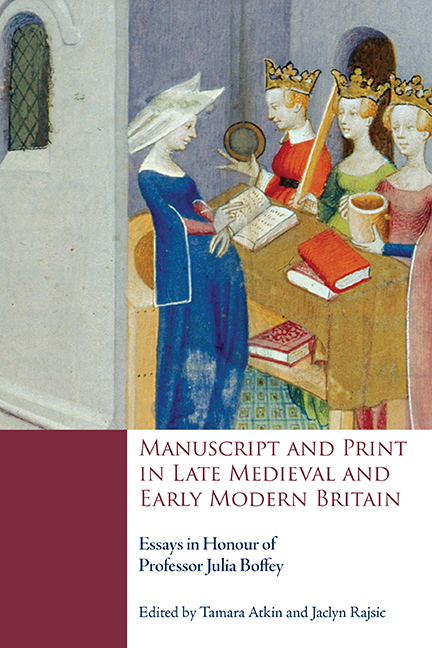 Manuscript and Print in Late Medieval and Early Modern Britain
Manuscript and Print in Late Medieval and Early Modern Britain Book contents
- Frontmatter
- Contents
- List of Illustrations
- List of Contributors
- Acknowledgements
- List of Abbreviations
- Introduction
- PRODUCING TEXTS
- READING INFLUENCE
- 8 Writing Revelation: The Book of Margery Kempe
- 9 ‘What strange ruins’: Reading Back to Thebes
- 10 Tyre in Africa: Dido's Flight and Sallust's Jugurtha
- 11 Trinitarian Piety and Married Chastity in The Pistel of Swete Susan
- 12 True Image? Alternative Veronicas in Late Medieval England
- 13 The Curelesse Wound: Henry Howard, Earl of Surrey and the Poetry of Blood
- Afterword
- Julia Boffey: A Bibliography
- Manuscript Index
- General Index
- Tabula Gratulatoria
11 - Trinitarian Piety and Married Chastity in The Pistel of Swete Susan
from READING INFLUENCE
Published online by Cambridge University Press: 06 September 2019
- Frontmatter
- Contents
- List of Illustrations
- List of Contributors
- Acknowledgements
- List of Abbreviations
- Introduction
- PRODUCING TEXTS
- READING INFLUENCE
- 8 Writing Revelation: The Book of Margery Kempe
- 9 ‘What strange ruins’: Reading Back to Thebes
- 10 Tyre in Africa: Dido's Flight and Sallust's Jugurtha
- 11 Trinitarian Piety and Married Chastity in The Pistel of Swete Susan
- 12 True Image? Alternative Veronicas in Late Medieval England
- 13 The Curelesse Wound: Henry Howard, Earl of Surrey and the Poetry of Blood
- Afterword
- Julia Boffey: A Bibliography
- Manuscript Index
- General Index
- Tabula Gratulatoria
Summary
IN TRIBUTE TO JULIA BOFFEY'S MANY IMPORTANT CONTRIBUTIONS to the study of Middle English poetry, I examine here a pleasing alliterative poem for which little modern analysis exists, despite obvious signs that its poet was accomplished and that his poem was widely read in England for close to a century beside such major texts as Piers Plowman. The Pistel of Swete Susan has been taken by modern critics to be little more than a paraphrase of the story of Susanna and the Elders in Daniel 13, which, though now apocryphal, was included in the medieval Vulgate Bible. The alliterative poet cared, however, about more than rendering a sacred text with a facade of vernacular ornamentation. Creative endeavours inevitably reflect the ideology of the culture for which and in which they are produced. The changes made by the poet are so delicate as not to alter the original story, yet they quietly impart a doctrinal lesson to a fourteenthcentury audience: that God in Trinity abides as the supreme third party in a sanctified Christian marriage. While foreign to the Vulgate original, this message distils ideas found in later patristic exegesis and liturgy.
As an exemplum on faith and married chastity, the biblical story of Susanna was universally recognized for how it features a miraculously efficacious prayer uttered at a dire moment. To revere the essence of this act, the Middle English poet constructs Susan so as to promote and reward a devout person's prayerful absorption of it: he encrypts into the poem the names and actions of the Triune Presence, unveiled progressively. Reading worshipfully, the meditant will feel that she has gained an affirming, divine response. Alexandra Barratt has detailed how women in religion were exhorted to undertake ‘hertely redyng’: ‘Clene and chast soules euer desiren so forto rede tat tei myght feele it sauourly with-in forth. Hertly redyng is a gracyous mene to gostly feling.’ The reading experience of Susan operates along similar lines. In detecting the enigma hidden plainly in Susan's lines, as would a medieval reader, we may glimpse the concerns of a society that sought such art for its edification.
- Type
- Chapter
- Information
- Manuscript and Print in Late Medieval and Early Modern BritainEssays in Honour of Professor Julia Boffey, pp. 203 - 218Publisher: Boydell & BrewerPrint publication year: 2019
